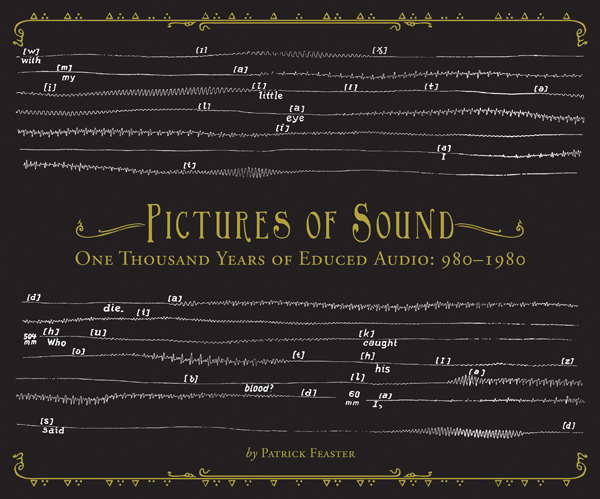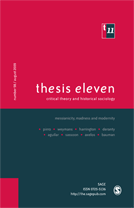Patrick Feaster: Pictures of Sound: One Thousand Years of Educed Audio, 980-1980 + CD (2012)
Filed under book, sound recording | Tags: · history of technology, media archeology, phonograph, sound, sound recording, technology

“Using modern technology, Patrick Feaster is on a mission to resurrect long-vanished voices and sounds—many of which were never intended to be revived.
Over the past thousand years, countless images have been created to depict sound in forms that theoretically could be “played” just as though they were modern sound recordings. Now, for the first time in history, this compilation uses innovative digital techniques to convert historic “pictures of sound” dating back as far as the Middle Ages directly into meaningful audio. It contains the world’s oldest known “sound recordings” in the sense of sound vibrations automatically recorded out of the air—the groundbreaking phonautograms recorded in Paris by Édouard-Léon Scott de Martinville in the 1850s and 1860s—as well as the oldest gramophone records available anywhere for listening today, including inventor Emile Berliner’s recitation of Der Handschuh, played back from an illustration in a magazine, which international news media recently proclaimed to be the oldest audible “record” in the tradition of 78s and vintage vinyl. Other highlights include the oldest known recording of identifiable words spoken in the English language (1878) and the world’s oldest surviving “trick recording” (1889). But Pictures of Sound pursues the thread even further into the past than that by “playing” everything from medieval music manuscripts to historic telegrams, and from seventeenth-century barrel organ programs to eighteenth-century “notations” of Shakespearean recitation.
In short, this isn’t just another collection of historical audio—it redefines what “historical audio” is.”
Publisher Dust-to-Digital, Atlanta/GA, 2012
144 pages, with 164 images
via prohairesis
Review: Randall Roberts (LA Times).
FirstSounds.org initiative
Patrick Feaster discusses Pictures of Sound (video, 36 min)
Author
Publisher
PDF, PDF (29 MB, updated on 2018-3-29)
ZIP (CD, 92 MB, ZIP’d OGG, updated on 2016-12-23)
Sensate: A Journal for Experiments in Critical Media Practice (2012-)
Filed under journal | Tags: · archive, art, digital humanities, ethnography, film, history of technology, media archeology, media art, photography, sensory ethnography, sociology, sound, video, visual anthropology

Sensate is a peer-reviewed, issueless, open-access, media-based journal for the creation, presentation, and critique of innovative projects in the arts, humanities, and sciences. Its mission is to provide a scholarly and artistic forum for experiments in critical media practices that expand academic discourse by taking us beyond the margins of the printed page. Fundamental to this expansion is a re-imagining of what constitutes a work of scholarship or art.
Editors-in-Chief: Lindsey Lodhie, Peter McMurray, Joana Pimenta, and Elizabeth Watkins
Creative Commons 3.0 Attribution license
Thesis Eleven 107(1): Special Section on Friedrich Kittler (2011)
Filed under journal | Tags: · media archeology, media theory, technology

“Friedrich A. Kittler was the most important, original and controversial German media theorist of his time. Departing from a philological background in German literature and arriving at a theory that combines the questions of technology, discourse and power, his oeuvre has had considerable impact on scholarship in the humanities over the past three decades. In contrast to Marshall McLuhan, who also started his career as a scholar in philology, Kittler’s theory is not anthropological in its epistemological set-up – media are not extensions of man; rather, Kittler’s theory is modelled after a Foucauldian-style archaeology but without Foucault’s ‘blind’ restriction to the medium of print.
Kittler’s works have either ‘produced’ ardent followers or have attracted vitriolic comments. These strong reactions to his works can in part be ascribed to his own academic style, which does not shy away from polemic commentary. Most of it is spurred by Kittler’s early desire to overcome a traditional type of literary criticism that ignores the impact of technology on the process of the production of meaning. And this lack of reflection is particularly apparent in the ‘art of interpretation’ (especially when this ‘art’ is relying on hermeneutics to justify its approach). Kittler’s work instead – strongly influenced by Shannon’s communication theory, Lacan’s writings on language and psychoanalysis and, as mentioned, Foucault’s archaeology of the humanities – attempted from early on to show how the technological dispositive (in various historical periods) is key to the cultural, societal and political environment at any time.
The scholarly articles and essays of this issue set out to introduce Kittler to the reader. The aim is to further a broader reception of his work in the anglosphere, and in particular in Australia, where he remains virtually unknown.” (from the Introduction)
With contributions by Geoffrey Winthrop-Young, Peter Krapp, Markus Krajewski, Matthias Bickenbach, Niels Werber, and Axel Fliethmann.
Publisher SAGE, November 2011
65 pages
PDF (updated on 2019-11-3)
Comments (3)
